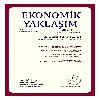Türkiye'de 1994,2001 ve 2008-9 ekonomik krizlerinin karşılaştırmalı analizi
Economic crises in Turkey: A comparative analysis of failures in 1994,2001 and 2008-9
___
- BAĞIMSIZ SOSYAL BİLİMCİLER (2009), Türkiye’de ve Dünyada Ekonomik Bunalım, 2008-2009, İstanbul: Yordam Kitap.
- ---------- (2007), IMF Gözetiminde On Uzun Yıl, 1998-2008: Farklı Hükümetler, Tek Siyaset (2’nci Baskı), İstanbul: Yordam Kitap.
- BORATAV, K. (2010), “Türkiye’nin Krizi Kasım’da Son Buldu”, Sol Haber Portalı, 17 Ocak.
- ---------- (2009), “Dış Kaynak Hareketlerinin Seyri”, Sol Haber Portalı, 20 Eylül.
- BURNSIDE, C., EICHENBAUM, M. ve REBELO, S. (2008), “Currency Crises Models”, S. N. Durlauf ve L. E. Blume (der.), The New Palgrave Dictionary of Economics (2nd Edition) içinde.
- ----------- (2004), “Government Guarantees and Self -fulfilling Speculative Attacks”, Journal of Economic Theory, 119(1), 31-63.
- ---------- (2001a), “Prospective Deficits and the Asian Currency Crises”, Journal of Political Economy, 109 (6), 1155-97.
- ----------- (2001b), “Hedging and Financial Fragility in Fixed Exchange Rate Regimes”, European Economic Review, 45 (7), 1151-93.
- CHANG, R. ve VELASCO, A. (2001), “A Model of Financial Crises in Emerging Markets”, Quarterly Journal of Economics, 116 (2), 489-517.
- CORSETTI, G., PESENTI, P. ve ROUBINI, N. (1999), “Paper Tigers? A Model of the Asian Crisis”, European Economic Review, 43 (7), 1211-36.
- DUMÉNIL, G ve LÉVY, D. (2005), “Costs and Benefits of Neoliberalism: A Class Analysis”, G. Epstein (der.), Financialization and the World Economy içinde.
- ----------(2004), Capital Resurgent, Cambridge, MA: Harward University Press.
- EICHENGREEN, B. ve HAUSMANN, R. (1999), “Exchange Rates and Financial Fragility”, NBER Working Paper No. 7418.
- EPSTEIN, G. (der.) (2005), Financialization and the World Economy, Cheltenham: Edward Elgar.
- FLOOD, R. P. ve GARBER, P. M. (1984), “Collapsing Exchange Rate Regimes: Some Linear Examples”, Journal of International Economics, 17(1-2), 1-13.
- INDEPENDENT SOCIAL SCIENTISTS ALLIANCE OF TURKEY (ISSAT) (2006), Turkey and the IMF: Macroeconomic Policy, Patterus of Growth and Persistent Fragilities, Penang: Third World Network.
- KAMINSKY, G.L. ve REINHART, C. M. (1999), “The Twin Crises: The Causes of Banking and Balance of Payments Problems”, American Economic Review, 89(3), 473-500.
- KRUGMAN, P. (1979), “A Model of Balance of Payments Crises”, Journal of Money, Credit and Banking, 11 (3), 311-25.
- OBSTFELD, M. (1996), “Models of Currency Crises with Self-fulfilling Features”, Europan Economic Review, 40(1), 1037-47.
- ----------- (1994), “The Logic of Currency Crises”, Cahiers Economiques et Monétaires, 43, 189-213.
- ORHANGAZİ, Ö. (2008), Financialization and the US Economy, Cheltenham: Edward Elgar.
- ÖZATAY, F. (2009), Finansal Krizler ve Türkiye, İstanbul: Doğan Kitap.
- ÖZKAN, F.G. ve SUTHERLAND, A. (1994), “A Model of the ERM Crises”, CEPR Discussion Paper, No.879.
- TÜREL, O. (2009), “Dünya Ekonomik Bunalımının Türkiye’ye 2008-2009’daki Yansımaları Üzerine Notlar”, Finans, Politik ve Ekonomik Yorumlar, 46 (533), 9-34.
- YELDAN, E. (2010) “Ekonomide İkilemler Çoğalıyor”, Cumhuriyet, 10 Mart.
- ---------- (2001), Küreselleşme Sürecinde Türkiye Ekonomisi : Bölüşüm, Birikim ve Büyüme, İstanbul: İletişim Yayınları.
- YÜKSELER, Z. (2009), “Türkiye’de Kriz Dönemlerinde Ekonomik Gelişmeler ve Ödemeler Dengesi Uyumu”, Ankara: TCMB (Haziran), erişim: zafer.yukseler@tcmb.gov.tr.
- ISSN: 1300-1868
- Yayın Aralığı: 3
- Yayıncı: Ekonomik Yaklaşım Derneği
Türkiye'de 1994,2001 ve 2008-9 ekonomik krizlerinin karşılaştırmalı analizi
Küresel ekonomik beklentiler: Resesyon geçmiş olabilir ama nereye kadar?
Krizin Türkiye ekonomisine yansımaları ve geleceğe ilişkin düşünceler
Rahmi Aşkın TÜRELİ, Aziz KONUKMAN
Bir küresel kamu malı olarak finansal istikrar: Eleştirel değerlendirmeler
Kalkınmanın finansmanı,emperyalizm ve finansal serbestlik üçgeninde dış borçlanma
